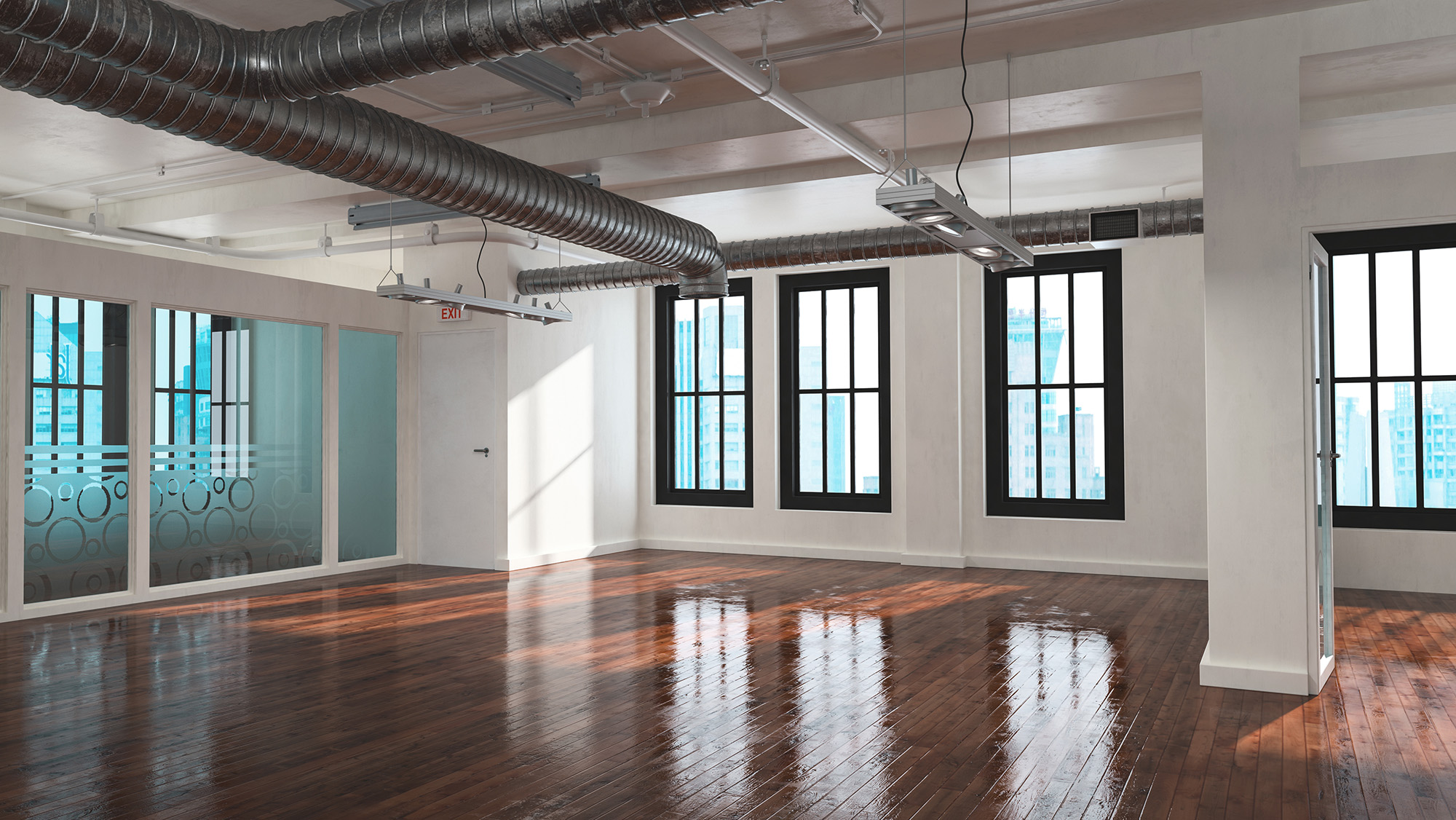Talk of office-to-residential conversions are everywhere these days. But these conversions aren’t as simple as they may seem—there are many engineering opportunities and challenges involved, and developers will be well served by having a full-service team in place before they begin.
In this latest blog in IMEG’s series on the topic, I talked with our technology, acoustics, and lighting experts about issues to review in the initial stages, and how those disciplines can impact a successful office to residential conversion.
1. Acoustics and Noise Abatement
Advice from Davin Huston and David Wright, Technology Designers of Distinction, Acoustics & Noise Abatement
The key to acoustics and noise abatement is to understand residential quiet, particularly for a condominium project. An office is not a bedroom and noise control is much different in an office than in a home. People want to sleep and live without hearing others next to them 24/7, so the expectations are different. Owners/developers should include an expert who knows about noise transfer and how an office building may or not meet standards and codes. It’s more than patching the building up or adding a few layers of drywall.
Acoustic standards and local isolation codes between units vary by municipality, but in the planning stages, two issues will drive your budget:
- Are you planning private ownership or condominiums? Tenant ownership will drive an entirely different design, notably for noise and barriers and floor impact. It’s more stringent than apartments. Condo owners are less tolerant of foot fall noise and will worry about resale value if there is noise intrusion.
- Are you pursuing LEED Well certification? Codes vary by state unless you’re pursuing LEED, which has a fundamental for acoustic comfort readily available. Those metrics will drive the scope, minimum standard of care, and budget, and the design scope can be predicted in advance to understand budget viability.
Next, focus on unit-to-unit separation with a common demising wall. Will you put holes in the walls for electrical boxes, ducts, loudspeakers, subwoofers, or recessed kitchen lighting? They will need to be assessed and benchmarked for percentage openings and noise flanking between the units. This will depend on a site test to understand where the noise is and if the assembly can be worked with. Look out the windows for outside noise from transportation or interstates. In downtown areas, those second or third floor units will be closer to street level, which means noise from the street, pedestrians, and loading docks.
In office-to-residential conversions, the living spaces are often placed along the outside where there are windows. A large commercial window may be attractive for daylight offices, but not for sleeping. What will the center space become? Elevators, communal spaces, a home theater? Think about how structural noise is not absorbed by soft goods. That noise will flow very fast in the structure to adjacent units, too, through the hallway doors and openings, via new wall penetrations, and through the new HVAC systems.
Inside the residential units, the structure of the floor will impact noise control and a soft, thin pad will not be enough under new flooring. The sounds of footsteps—footfall impact—can be a 24/7 noise from above. It needs to be remedied at the ceiling and above the floor level. The impact noise or vibration travels though floorboards in walls, through concrete. Sleeping rooms will need more stringent solutions, too. One of the most common leaks around walls is the mullion to the window and the plastic pipe into the bath, from below. That pipe wall is ¼-inch to below noises, no matter how many gypsum layers you add to the walls.
Finally, be aware of your neighboring buildings. If you’re planning a rooftop bar or amenity space outside or on grade, with people gathering against the property line, you need a solution for that noise. And they won’t like it when the air handling unit is a simple, open slat screen.
2. Technology
Advice from Jeff Burton, Client Executive, Technology Design Services
The unique nature of low-voltage systems, technology, and lighting can also impact the quality of life for the building’s occupants. But there’s no specific code to follow. Instead, it comes down to budget and the experience you want to provide your residents. As with acoustics, condominium owners will expect a higher level of features.
If the building has an outdated security control system, you’ll want to replace it. Residents will prioritize locking hardware type, ease of use, and guest access. Typically, the topology of an office access control system isn’t going to allow for a smooth conversion to a residential application, and trying to modify it can generate some significant costs.
Technology mobility is constantly evolving, but post-pandemic residents will need the ability to seamlessly work remotely from their portable devices. Future 5G offerings from cellular carriers may offer the expected reliability as a retrofit consideration, but the traditional structured cable solutions of fiber optic and copper infrastructure found in new construction are the benchmark of speed and reliability.
Expanding the legacy cable infrastructure and adding an engineered Wi-Fi solution can achieve the expected mobility and performance for residents and connectivity for most of the buildings operational functions. This converged approach can be cost effective and scalable and allows for many of the convenience functions, like smart locks, which attract tenants. Cost savings come from having a well-planned design approach proportional to the resident experience goals, not from over-investing in cable infrastructure and pathways that are not used.
Developers of new construction projects consider technology a marketing opportunity and converged building-wide solutions are commonplace. Find value by implementing these applications, which are no longer designed from a standalone building-wide perspective. Instead, operators choose from a number of hosted solutions that meet amenity and experience objectives. Although the same structured cable connectivity is required, software and control infrastructure are now cloud-based, which can be a cost-savings. It also means the building manager is spared 4 a.m. phone calls when a tenant can’t get their smart lock to unlock their door.
3. Lighting Design
Advice from Shanna Olson, Architectural Lighting Design Leader
Tenant expectations for lighting and lighting controls have evolved in recent years.
On the lighting side, as LED has become the standard, many owners or renters expect LED luminaires both in their units and the amenity spaces. There is a potential to reuse existing downlights or other luminaires but consider the luminaire condition, the light source, cost to remove, store and relocate, and if they fit within the new space.
In a historic building, where retaining the historic elements and feel is more critical, there may be greater value to reusing existing luminaires. They may need to be rewired and could be provided with an LED source.
Dimming control, at minimum, is expected in front-of-house spaces, and digitally enabled/smart control systems are becoming an expectation in units. If luminaires are reused, consider dimming and the coordination with control stations. Depending on the existing control system components, portions of the system, particularly in the core spaces, may be reused and built upon. The existing dimming protocol is the key to how much can be reused. In many circumstances, a new control system may be desired in the units, but like other technology, the cost on these systems has come down and they are readily available.
Office-to-residential conversion conclusion
The success of a project stems from having your subject experts involved early in the process. They can help develop a strategy that meets your expectation of the resident experience. Technical issues can be overcome, and budget constraints worked within, but that’s easier to do that with advanced planning.
More from Author
IMEG Corp. | Jun 18, 2024
A healthcare simulation technology consultant can save time, money, and headaches
As the demand for skilled healthcare professionals continues to rise, healthcare simulation is playing an increasingly vital role in the skill development, compliance, and continuing education of the clinical workforce.
IMEG Corp. | Jan 11, 2024
Designing for personal technology is crucial for senior living facilities
Today’s seniors are increasingly tech savvy. It isn’t enough to give senior living residents a pre-determined bundle of technology and assume that they’ll be satisfied.
IMEG Corp. | Sep 28, 2023
Structural engineering solutions for office-to-residential conversion
IMEG's Edwin Dean, Joe Gulden, and Doug Sweeney, share seven key focuses for structural engineers when planning office-to-residential conversions.
IMEG Corp. | Jun 12, 2023
Drones take site assessments to new heights
Eric Vallejo, Director of Reality Capture and Geospatial Solutions, IMEG Corp., discusses strategies for using visualization and reality capture.
IMEG Corp. | Apr 20, 2023
13 trends, technologies, and strategies to expect in 2023
Biophilic design, microgrids, and decarbonization—these are three of the trends, technologies, and strategies IMEG’s market and service leaders believe are poised to have a growing impact on the built environment.
IMEG Corp. | Nov 16, 2022
SPC-4D: 7 reasons California hospital building owners should act now to meet seismic compliance
Seismic compliance with the applicable California building codes is onerous and disruptive for building owners, especially for a building in the heavily regulated sector of healthcare. Owners of older buildings that house acute care services have a big deadline on the horizon—Jan. 1, 2030, the cutoff date to upgrade their buildings to SPC-4D.
IMEG Corp. | Aug 1, 2022
Achieving a net-zero K-12 facility is a team effort
Designing a net-zero energy building is always a challenge, but renovating an existing school and applying for grants to make the project happen is another challenge entirely.
IMEG Corp. | Apr 19, 2022
6 trends to watch in healthcare design
As the healthcare landscape continues to evolve, IMEG’s healthcare leaders from across the country are seeing several emerging trends that are poised to have wide-ranging impacts on facility design and construction. Following are six of the trends and strategies they expect to become more commonplace in 2022 and the years to come.
IMEG Corp. | Feb 18, 2022
Crime Prevention Through Environmental Design: Comprehensive strategies to keep people and buildings safe
CPTED is so much more than surface-level protection; it encompasses multiple phases of design, social programs, colors, lighting, natural surveillance, natural access control, and even traffic curbing.
IMEG Corp. | Feb 1, 2022
Sustainable design solutions will power EV charging stations
As the EV market share has been recognized, MEP firms have been tasked with the responsibility of an entirely new design: charging stations.

















